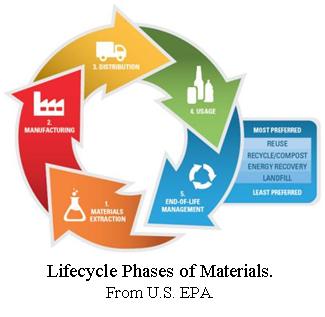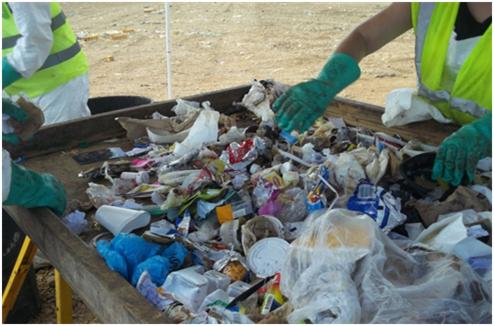Executive Order 01.01.2017.13, Resource Recovery Plan for Maryland
(1)
Adopts a
first-ever sustainable materials management (SMM) policy for Maryland that aims
to minimize the environmental impacts of the materials’ use throughout the
entire lifecycle;
(2)
Emphasizes
environmentally and economically sustainable methods to capture and reuse resources–
including everything from metals and plastics to energy, nutrients, and soil;
(3)
Initiates a
stakeholder consultation process to establish ambitious but achievable goals
and to ensure tracking of complete materials management data;
(4)
Empowers new
partnerships across State and local agencies, the agricultural, energy, and
transportation sectors, environmental organizations, and recycling innovators;
Tasks specific State agencies with critical
initiatives, such as siting, technical, and permitting assistance and
demonstration of innovative recycling technologies.
Announcements
What is Sustainable Materials Management (SMM)?

SMM is a comprehensive way of thinking about how
society uses materials. SMM involves understanding the flow of materials
through the environment and economy, from the extraction of raw materials to
the production, distribution, and consumption of products, and to the management
of those products at end-of-life. This flow is known as the “lifecycle” of
materials. SMM examines that lifecycle, often using a method known as
“lifecycle analysis” or LCA, to identify ways to use materials more efficiently
and in a manner that minimizes undesirable environmental impacts. SMM differs
in approach from traditional solid waste and recycling programs, which focus
primarily on the concept of “waste” – what happens to products at end-of-life.
In addition to looking at materials throughout all lifecycle stages, SMM can
also look more comprehensively at the environmental impacts of materials use,
including impacts to greenhouse gas emissions, energy consumption, water and
air quality, habitats, and the toxicity of chemicals in the environment. Finally, SMM
seeks to support a strong and sustainable economy by preserving the value of
recovered materials as useful, cost-effective inputs in the supply chain.
SMM is
critical to the overall goal of protecting the environment. The consumption of
materials is increasing globally and is responsible for a significant share of
the impacts of humans on the environment. For example, a 2009 U.S. EPA report
found that 42 percent of U.S. greenhouse gas emissions were associated with the
provision of food and other goods (full report here). The
Organization for Economic Co-operation and Development (OECD) notes that the
extraction of raw materials worldwide increased by 65 percent between 1980 and
2007 (see here). SMM
policies that reduce the need for raw material extraction can conserve not only
the raw materials themselves, but the energy, water, and other resources needed
to extract and transport them.
Increasingly, governments are using the
principles of SMM to guide planning and policy efforts, and the private sector
is using SMM concepts to inform everything from product and packaging design to
new technologies for resource recovery.
Maryland’s SMM Policy
The 2017
Executive Order adopted the following SMM policy for Maryland:
“It is the policy of the State that solid waste and
recycling planning should, to the extent practicable, seek to:
(1) Minimize the
environmental impacts of materials management over their entire life cycles,
including from product design to production, consumption, and end-of-life
management;
(2) Conserve and
extend existing in-State disposal capacity through source reduction, reuse, and
recycling;
(3) Capture and
make optimal use of recovered resources, including raw materials, water,
energy, and nutrients; and
(4) Work toward a
system of materials management that is both environmentally and economically
sustainable in the long term.”
Maryland Department of the Environment’s Work on SMM
Maryland
Statewide Waste Characterization Study
 The Department worked with the Northeast
Maryland Waste Disposal Authority to conduct a statewide study of the types of
wastes being disposed throughout Maryland. The final report from the study was
published in July 2017. For the study, crews sorted samples of incoming waste
at landfills and transfer stations throughout the State. The study provides
important data to assist the Department and local governments in determining
priority materials to target for SMM initiatives. The findings confirmed that
organics – particularly food scraps – are one of the most disposed materials in
the municipal waste stream. The study also showed that even some materials for
which recycling is widely available – cardboard, for example – continue to be
disposed in significant quantities, underscoring the need for more outreach.
The Department worked with the Northeast
Maryland Waste Disposal Authority to conduct a statewide study of the types of
wastes being disposed throughout Maryland. The final report from the study was
published in July 2017. For the study, crews sorted samples of incoming waste
at landfills and transfer stations throughout the State. The study provides
important data to assist the Department and local governments in determining
priority materials to target for SMM initiatives. The findings confirmed that
organics – particularly food scraps – are one of the most disposed materials in
the municipal waste stream. The study also showed that even some materials for
which recycling is widely available – cardboard, for example – continue to be
disposed in significant quantities, underscoring the need for more outreach.
Read the full study here.
Innovative Reuse of Dredged Materials and Other Soil and Fill MateriaThe
Executive Order calls for the Department to work with the Maryland Port
Administration to publish technical screening criteria and guidance on the reuse
of dredged materials. In August 2017, the Department published a guidance
document, in consultation with the Maryland Port Administration, on the
innovative and beneficial use of dredged materials, a fact sheet on the reuse
of soil and fill materials generally, and a new
cross-media dredged materials website.
SMM Goals and
MetricsThe
Executive Order calls for the Department to consult with stakeholders on the
State’s methodology for tracking waste generation, recycling, and source
reduction, and to (1) recommend to the Governor a method of obtaining business
source reduction and recycling data; (2) establish an improved method of
tracking the statewide recycling and source reduction rates; and (3) establish
voluntary statewide goals to encourage continuous improvement of SMM. In 2017,
the Department began meeting with stakeholders to obtain input on goals and
methodologies. The
final goals and metrics recommendations were pubished in April, 2019.
Working with
State Agencies and the Private Sector
The
Department has begun meeting with the state agencies named in the Executive
Order to identify areas of collaboration on SMM. For example, the Department of
Commerce and the Department of the Environment websites were adjusted to
include information on business assistance and permitting assistance provided
by the two agencies to better assist prospective recycling businesses
Plans for 2018
In 2018,
the Department will continue working on SMM and the initiatives laid out in the
Executive Order, including by:
- Continuing to
consult with stakeholders on the goals and measurement part of the Order;
- Recommending to
the Governor improved measurement methods and new goals;
- In accordance with
the Order’s call for outreach directed at key materials, planning a regional
Food Recovery Summit to provide outreach and information-sharing on diversion
of food scraps;
- Conducting a
stakeholder workgroup and study on yard waste, food residuals, and other
organic materials diversion and infrastructure (more information here);
- Conducting a
stakeholder workgroup to develop regulations governing recycling facilities,
including to clarify when a refuse disposal permit is not required for
recycling facilities (more information here); and
- Meeting with
additional State agencies and private sector groups working on SMM to identify
further areas of collaboration.
How to Get Involved